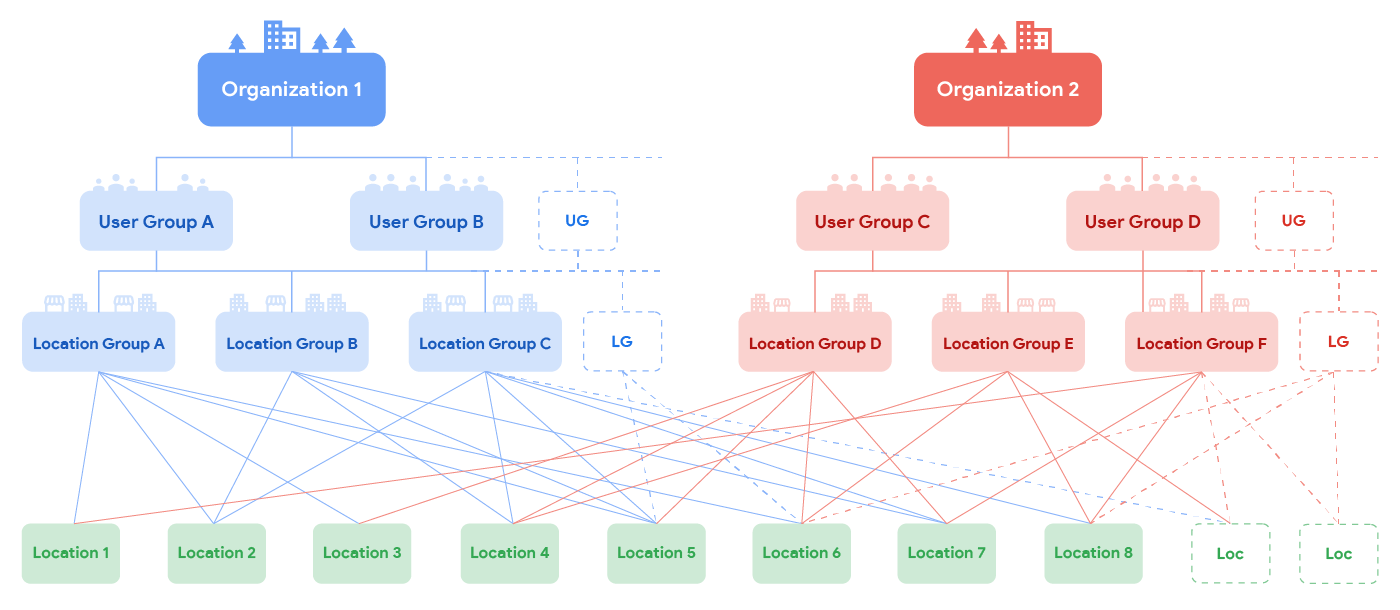随着组织不断成长,营业地点和权限的管理工作可能会让您不堪重负。本指南详细介绍了管理多个营业地点的最佳实践,并介绍了以下账号类型:
账号类型
在营业地点管理方面,每个账号类型都有各自的作用。个人账号可以管理组织账号,还可以获取该组织中的用户群组和营业地点组的权限。然后,该个人账号就可以通过关联的营业地点组管理营业地点和商家信息。
个人账号
创建 Google 账号时,系统会自动为您生成个人账号。个人账号可以是商家信息的所有者和管理员。
组织账号
组织账号是代表您的代理机构的上层账号。您的营业地点组和用户群组保存在组织账号中,组织中的所有成员都有权访问这些组。营业地点信息可以存在于多个组织账号中。
借助 My Business Account Management API,您可以使用 accounts.admins.create 方法邀请个人账号管理或拥有组织账号。
营业地点组账号
营业地点组可用于管理一组营业地点。您可以使用营业地点组对多个营业地点批量执行任务。将个人账号和用户群组添加到某个营业地点组后,它们会继承该营业地点组的权限。
您还可以创建营业地点组以按连锁店、地区或类别等对营业地点进行分类。营业地点可以同时存在于多个营业地点组中。
借助 My Business Account Management API,您可以使用 accounts.create 方法创建营业地点组,并将营业地点转移到营业地点组。您还可以通过该 API 邀请个人账号管理营业地点组。在网页界面上,您可以直接将用户群组添加到营业地点组。
用户群组账号
如需批量管理权限,请使用用户群组。您可以将多个个人账号添加到用户群组,然后授予该用户群组对组织内多个营业地点组的管理权限。这样,该用户群组中的所有个人账号便可对营业地点组中的营业地点执行管理操作。
例如,当新成员加入运营团队时,您可以直接将其添加到用户群组,这样该成员便可立即访问其同事有权访问的所有营业地点。如果向用户分别授予对各个营业地点的权限,不仅会花费更长的时间,管理起来也更加困难。
借助 My Business Account Management API,您可以使用 accounts.create 方法创建用户群组。您还可以使用该 API 邀请个人账号管理账号和营业地点的管理员。
使用 API 调用所有账号的列表
如需列出您有权访问的所有账号及其关联的账号类型,请使用您的 OAuth 凭据调用 accounts.list 方法。响应中会包含账号列表、对应的账号 ID(显示在 name 字段中),以及账号类型。
请求
以下是 accounts.list 请求示例:
GET https://mybusinessaccountmanagement.googleapis.com/v1/accounts Authorization: Bearer <access_token>
响应
以下是 accounts.list 响应示例:
{ "accounts": [ { "name": "accounts/{accountId}", "accountName": "John Doe", "type": "PERSONAL", "state": { "status": "UNVERIFIED" }, "profilePhotoUrl": "//lh5.googleusercontent.com/REDACTED" }, { "name": "accounts/{accountId}", "accountName": "John Doe’s Location Group", "type": "LOCATION_GROUP", "role": "OWNER", "state": { "status": "UNVERIFIED" }, "accountNumber": "{accountNumber}", "permissionLevel": "OWNER_LEVEL" } ] }
本指南详细介绍的所有账号类型都可能会包含在对您的 accounts.list 请求做出的响应中。请查看账号列表,确定哪个账号有权访问您要管理的营业地点。然后,使用此账号的 name 字段调用 accounts.locations.list,以检索该账号有权访问的营业地点列表。
例如,如果您想检索属于“张三的营业地点组”的所有营业地点,请发出以下请求:
GET
https://mybusinessbusinessinformation.googleapis.com/v1/{accountId}/locations
Authorization: Bearer <access_token>
响应将返回该用户有权访问的营业地点列表,如下所示:
{
"locations": [
{
"name": "locations/{locationId}",
"locationName": "Test Business",
...
},
{
"name": "locations/{locationId}",
"locationName": "2nd Test Business",
...
}
]
}营业地点管理示意图
下图说明了以下内容:
- 一个组织可以包含多个用户群组。
- 一个用户群组可以管理多个营业地点组。
- 一个营业地点组可以包含多个营业地点。
- 同一营业地点可以存在于组织的多个营业地点组中。
